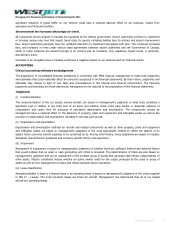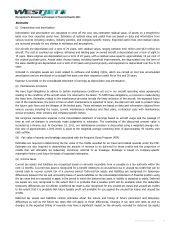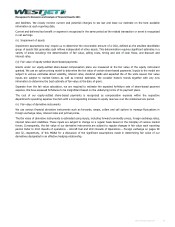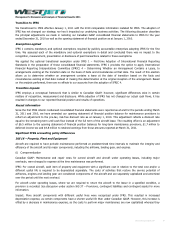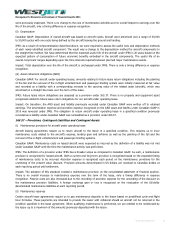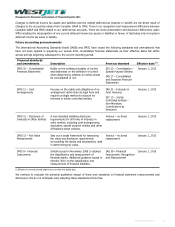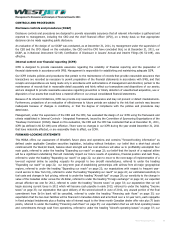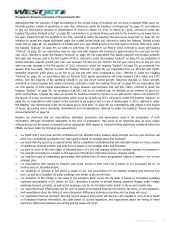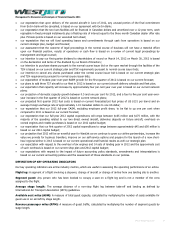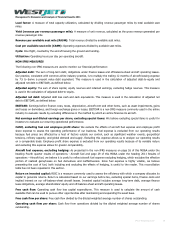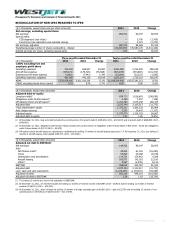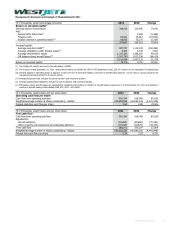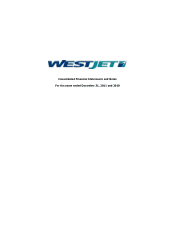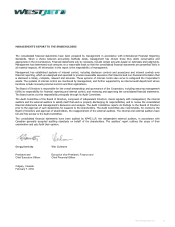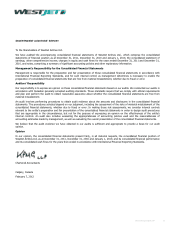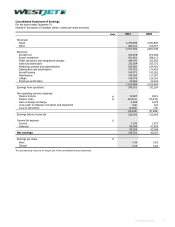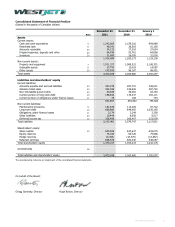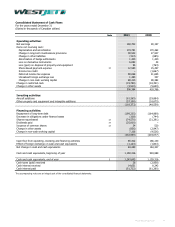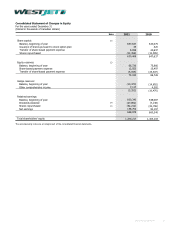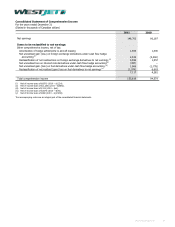Westjet 2011 Annual Report Download - page 58
Download and view the complete annual report
Please find page 58 of the 2011 Westjet annual report below. You can navigate through the pages in the report by either clicking on the pages listed below, or by using the keyword search tool below to find specific information within the annual report.
Management’s Discussion and Analysis of Financial Results 2011
│
Load factor: A measure of total capacity utilization, calculated by dividing revenue passenger miles by total available seat
miles.
Yield (revenue per revenue passenger mile): A measure of unit revenue, calculated as the gross revenue generated per
revenue passenger mile.
Revenue per available seat mile (RASM): Total revenue divided by available seat miles.
Cost per available seat mile (CASM): Operating expenses divided by available seat miles.
Cycle: One flight, counted by the aircraft leaving the ground and landing.
Utilization: Operating hours per day per operating aircraft.
NON-IFRS MEASURES
The following non-IFRS measures are used to monitor our financial performance:
Adjusted debt: The sum of long-term debt, obligations under finance leases and off-balance-sheet aircraft operating leases.
Our practice, consistent with common airline industry practice, is to multiply the trailing 12 months of aircraft leasing expense
by 7.5 to derive a present value debt equivalent. This measure is used in the calculation of adjusted debt-to-equity and
adjusted net debt to EBITDAR, as defined below.
Adjusted equity: The sum of share capital, equity reserves and retained earnings, excluding hedge reserves. This measure
is used in the calculation of adjusted debt-to-equity.
Adjusted net debt: Adjusted debt less cash and cash equivalents. This measure is used in the calculation of adjusted net
debt to EBITDAR, as defined below.
EBITDAR: Earnings before finance costs, taxes, depreciation, aircraft rent and other items, such as asset impairments, gains
and losses on derivatives, and foreign exchange gains or losses. EBITDAR is a non-IFRS measure commonly used in the airline
industry to evaluate results by excluding differences in the method by which an airline finances its aircraft.
Net earnings and diluted earnings per share, excluding special items: We believe excluding special items is useful for
investors to evaluate our recurring operational performance.
CASM, excluding fuel and employee profit share: We exclude the effects of aircraft fuel expense and employee profit
share expense to assess the operating performance of our business. Fuel expense is excluded from our operating results
because fuel prices are affected by a host of factors outside our control, such as significant weather events, geopolitical
tensions, refinery capacity, and global demand and supply. Excluding this expense allows us to analyze our operating results
on a comparable basis. Employee profit share expense is excluded from our operating results because of its variable nature
and excluding this expense allows for greater comparability.
Aircraft fuel expense, excluding hedging: As presented in the non-IFRS measures on page 26 of this MD&A under the
heading Fourth quarter results of operations - Aircraft fuel and page 29 of this MD&A under the heading 2011 Results of
operations – Aircraft fuel, we believe it is useful to reflect aircraft fuel expense excluding hedging, which excludes the effective
portion of realized gains/losses on fuel derivatives and ineffectiveness. Since fuel expense is highly volatile, we believe
presenting the cost of fuel, both including and excluding the effects of hedging, is useful to the reader. This reconciliation
table has not been repeated in this section.
Return on invested capital: ROIC is a measure commonly used to assess the efficiency with which a company allocates its
capital to generate returns. Return is calculated based on our earnings before tax, excluding special items, finance costs and
implied interest on our off-balance-sheet aircraft leases. Invested capital includes average long-term debt, average finance
lease obligations, average shareholders’ equity and off-balance-sheet aircraft operating leases.
Free cash flow: Operating cash flow less capital expenditures. This measure is used to calculate the amount of cash
available that can be used to pursue other opportunities after maintaining and expanding the asset base.
Free cash flow per share: Free cash flow divided by the diluted weighted average number of shares outstanding.
Operating cash flow per share: Cash flow from operations divided by the diluted weighted average number of shares
outstanding.
WestJet Annual Report 2011 58


